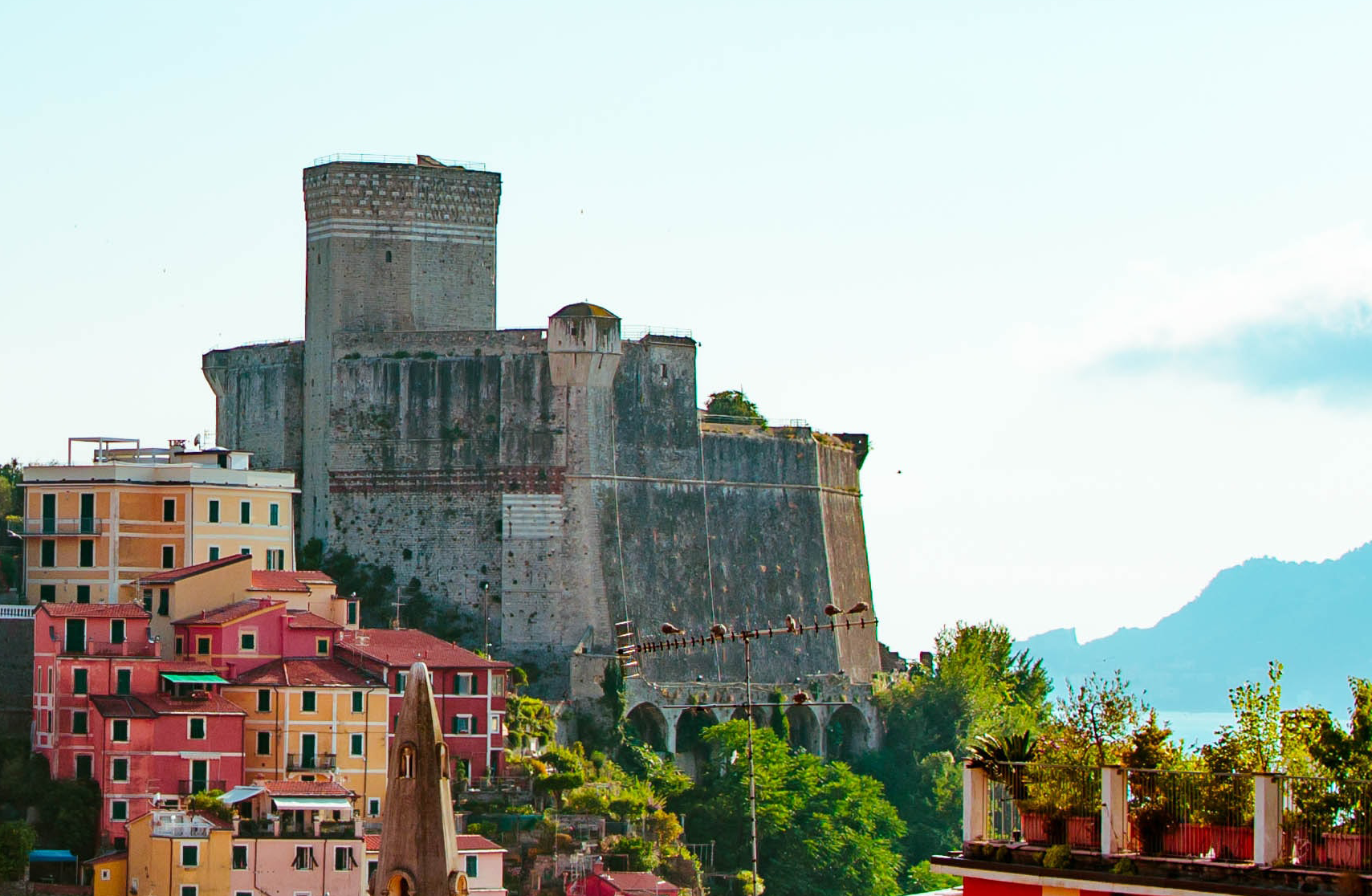
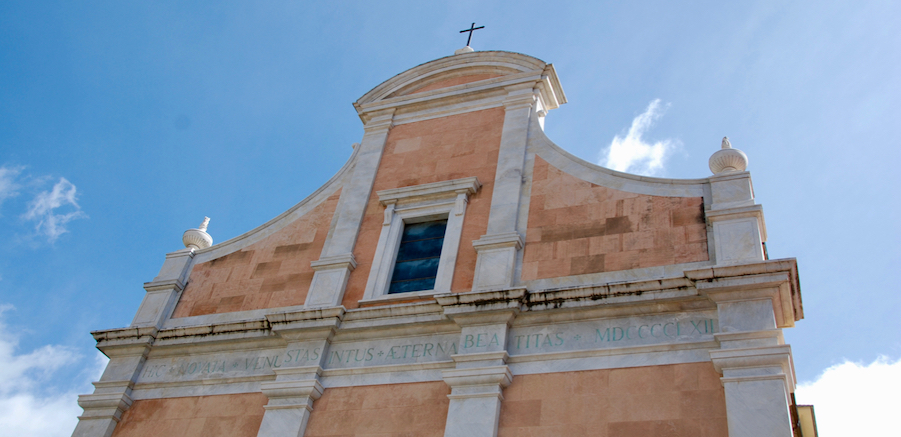
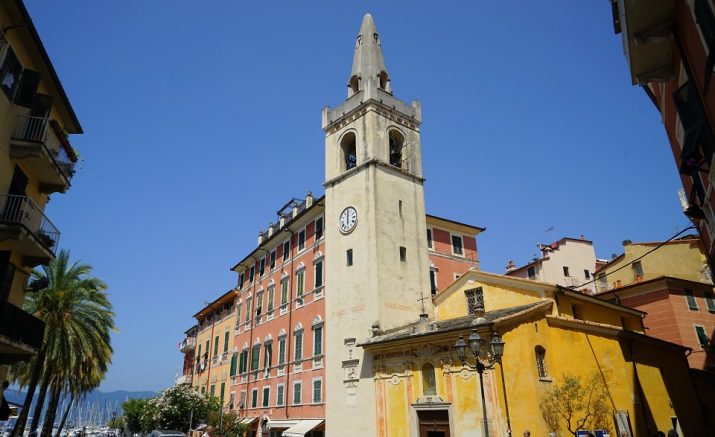
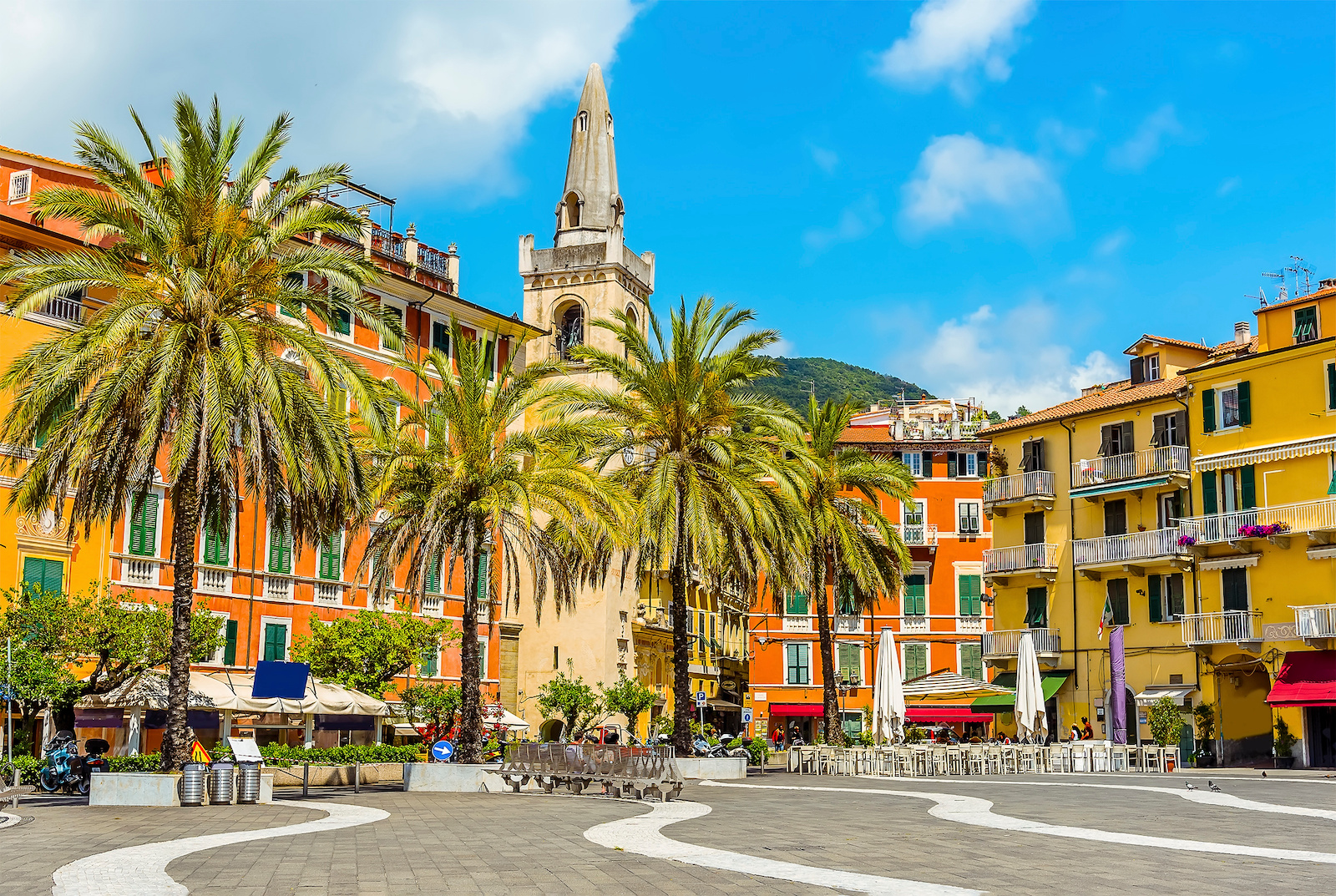
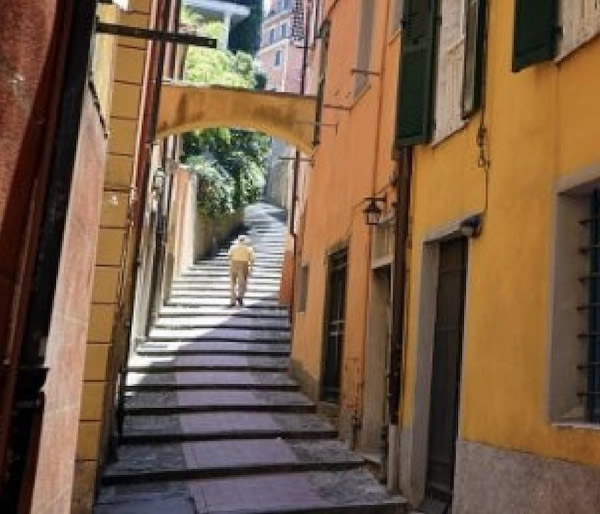
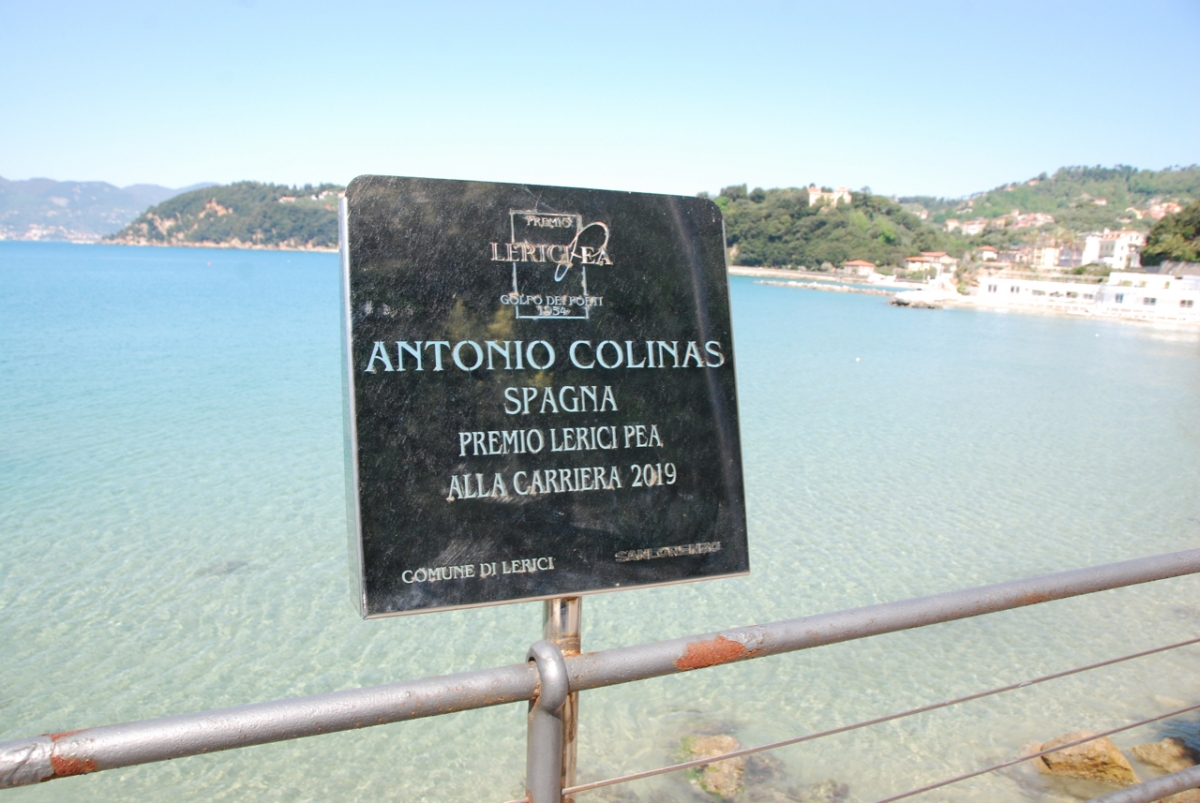

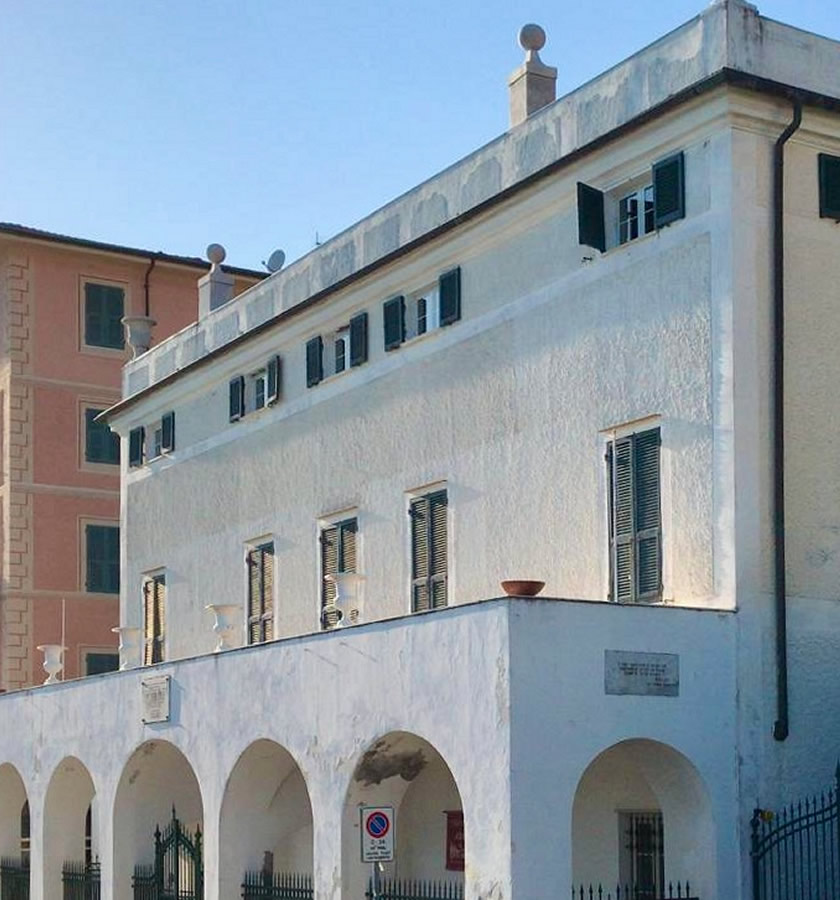
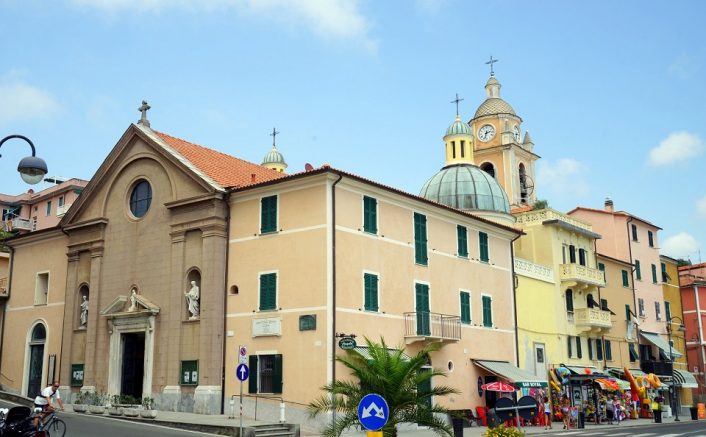

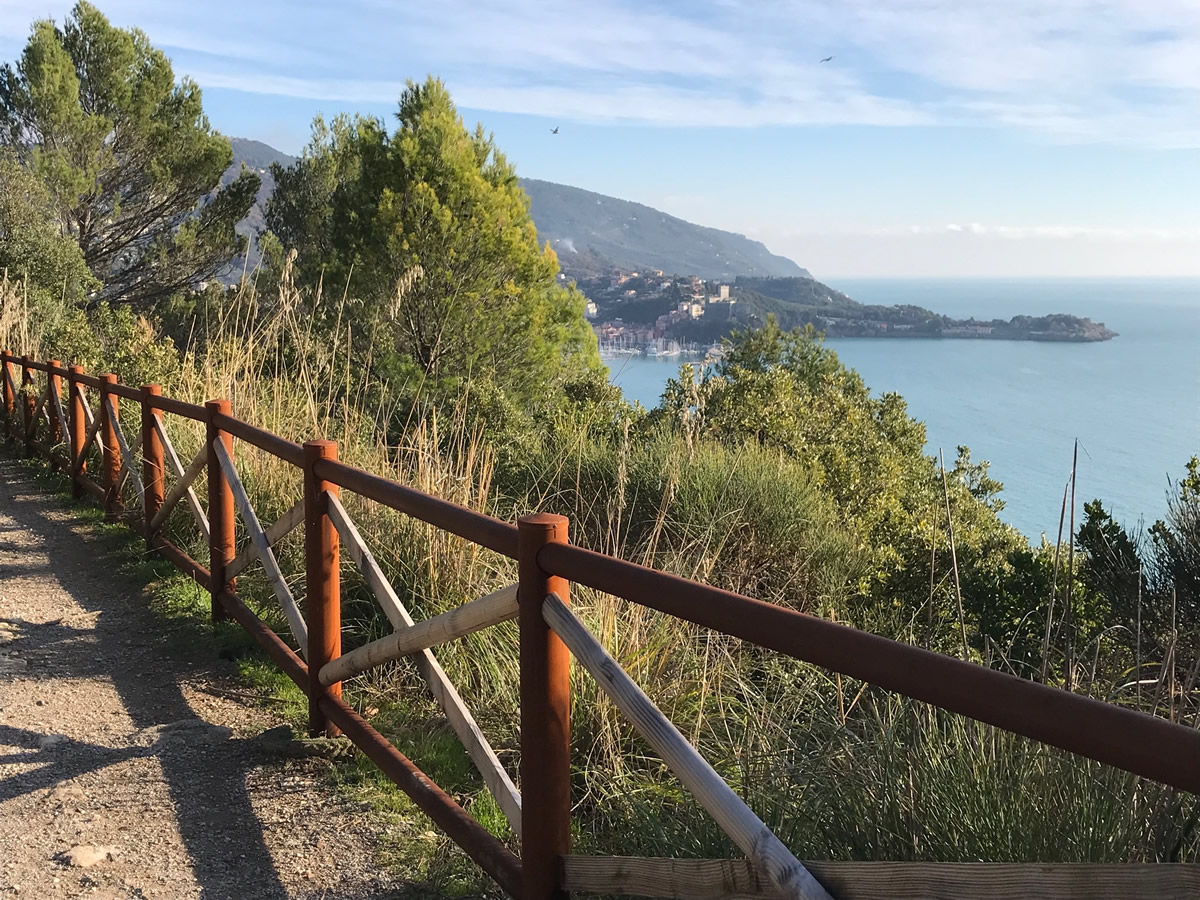
The Castle of Lerici
The Castello San Giorgio stands, in a dominant position, on the top of the rocky promontory that closes the bay of Lerici to the south which, in the Middle Ages, was a trading and free port, therefore, it was not fortified. It was the Pisans, after having defeated the Genoese in the Battle of Giglio (1214), to build the first nucleus of today’s Castle.
Discover more
The current building, constructed in an unconventional geometric shape, is the result of numerous changes and remodelling over the centuries that incorporated the oldest core, and that of its original Pisan foundation.
The reconquest of Lerici (1256) and the substantial defeat suffered by Pisa at the Battle of Meloria (1284), marked the definitive supremacy of Genoa in the western Mediterranean: from then on, the Castle’s fortunes followed the history of the Superba (“the Superb one”), characterised by extreme political instability, with violent internal struggles and the interference of foreign powers (the Visconti, French, Florentines, kingdom of Aragon, and the Sforza, etc.), until it came under the powerful Officio di San Giorgio, in the second half of the fifteenth century. Throughout these centuries of changing fortunes, the building maintained its military functions and was used as a prison, guarded by a castellan and garrisons of soldiers. Due to its strategic importance as a fortress on the eastern border of the Genoese territory, the Castle of Lerici was fortified and raised several times, until the last “incamiciatura” (encasement) in 1555: the sloping talus was able to resist attacks by military weapons, and in some parts, it was more than six metres thick for this very reason. For centuries, the Castle of Lerici was a high-security Genoese prison: many high-ranking prisoners were incarcerated there, and countless death sentences were carried out, especially against Corsican rebels. Francis I King of France, was also imprisoned here, brought here after his defeat at Pavia by the Spaniards of Charles V (1525). Andrea Doria locked himself up there to defend himself from the French fleet that came to Lerici to take him prisoner when the great admiral entered the service of Charles V of Spain (1528).
Church of San Francesco
It is the second church dedicated to the saint, because the first one (14th century) became insufficient for the growing population of the village. A column of the first church, demolished in 1632, is still visible in the churchyard of today’s parish church.
Discover more
The second church was completed in 1636. At the end of the eighteenth century, the church was further enlarged with the construction of the choir. The marble façade dates back to 1962. The bright frescoes on the ceiling also date from the twentieth century and are the work of the La Spezia painter Luigi Agretti. They represent St. Erasmus, protector of sailors, calming the storm, the glory of St. Francis and the narration of the miraculous finding of the so-called Madonna of Maralunga on the cliffs by three fishermen from Lerici.
The chapel dedicated to the Madonna of Maralunga, patron saint of Lerici and celebrated on March 25th, is of extraordinary artistic and devotional value. According to tradition, the precious panel whose iconography is unique in that it depicts two Madonnas with the Child side by side, was miraculously found by three fishermen near the promontory of Maralunga in 1480. In reality, it now seems certain that the work was commissioned: in the painting, we can read these words “Colottus. q. Jacopelli et Petrus Dominicus Muttini T.F.1480”, i.e. the surnames of the three discoverers and the initials of “testes fuerunt”. Someone later added the word “invenerunt” (i.e. they found) on the painting, after
the names of the discoverers. Restoration work has shown that the original layer of paint bore the letters “F.F.”, meaning, “fecerunt facere”. The painting was commissioned to a Tuscan painter, recommending that he should reproduce the cartouche of the Madonna Bianca of Porto Venere, which reads, Madre Mia ço che te piaxe me contenta purch’el pecatore del mal fare se penta” (14th century). In fact, this is how the Lerici cartouche reads: “Madre Mia ço che te piaxe me contenta purch’el pecatore del mal fare se penta”, in a more developed Italian (15th century). The Madonna, dressed in a green garment, is almost exactly identical to the Madonna dell’Arena, which, according to tradition was caught in the net of the fishermen of San Terenzo.
Saint Rocco Oratory
The original church, built outside the walls, was dedicated to Saints Martin and Christopher, and dates back to 1287. In an outside corner, known as “er canto”, medieval notaries drew up their deeds, while the present bell tower was originally a watchtower, an outpost guarding a ford over the stream that flowed right in front of the building, on the route of today’s Via Petriccioli.
Discover more
In the 16th century, Lerici was struck by a terrible plague. When the tragedy was over, the church was consecrated to Saint Rocco (1524), patron saint against plagues, a figure that stands out in the lunette above the entrance portal. Today, the church is decorated in the Baroque style and inside there are precious works of art, while on the façade of the bell tower there are plaques with medieval inscriptions that remind us of its medieval origin.
Piazza Mottino “Il Piasseo”
The name of the square comes from a family of intellectuals, prelates and admirals, who came at the head of a papal fleet. In ancient times it was reached by the sea, filled with excavations of the “Tagliata”, a road built to reach Maralunga. From here you can access the oldest part of the medieval village, also called Borgo Pisano, because it was built by Pisa in 1241.
Discover more
We can still see a tower, with an entrance doorway, surmounted by a pointed arch, which leads to one of the most evocative “carruggi” (narrow alleyways) of Lerici, called in dialect “caróbio d’en fóndo”, which later became Via Ambrogio Giacopello (a patriot of the Risorgimento from Lerici, a Mazzinian, who died in exile in Marseille). Here it is possible to see a marble overdoor that could be the legacy of one of the oldest churches in Lerici: Santa Marta, destroyed by the Saracens.
Today, there is only one tower in Piazza Mottino, but in the past Lerici was known as the “town of seven towers”. This small square, once lapped by the sea, was the site of various shipbuilding activities that took place. There were foundries for the production of cannons, which were loaded in the harbour on brigantines bound for Corsica, which was suffering from a serious uprising against Genoa (15th century). The three small alleys that open onto Piazza Mottino today lead to the Calata, but in the past, they led to a part of the village that has now disappeared, because the Germans destroyed it in 1944, giving life to the square of the pier.
Starting from Piazza Mottino, it is possible to pleasantly lose oneself in the alleys of the most ancient Lerici. In fact, there are paths that lead to the top of the promontory and to the Castle of San Giorgio.
One of them is Via del Ghetto, so called because it once housed the Jewish ghetto, enclosed between two gates that no longer exist. A plaque at the entrance to the ascent recalls its history, linked to the transfer of Sephardic Jews who came to Lerici in the sixteenth century to work in activities such as foundry, textile processing, shipbuilding and trade. A large number of Ligurian surnames still bear witness to their Jewish origin, although over the centuries a gradual integration with the local population took place. After the discovery of a Torah, hidden in the walls of the house in Via del Ghetto 1, it was assumed that the synagogue was located here.
Ca’ Doria e la Carpaneta
The narrow Via Doria, which leads from Piazza Garibaldi up the hill between the houses, was once called “Carpaneta”. The etymology of the name is due to the presence of hornbeams. In the 15th and 16th centuries, noble residences were built here, one of which became the summer residence of Admiral Andrea Doria, who decided to leave the French service for the Spanish right here. The year was 1528 and from that moment on, the history of Europe changed course.
Discover more
The event is commemorated by a plaque, visible inside the dwelling, which is due to be opened to the public soon: <D.O.M AND. AB AURIA HUIUS DOMUS HOSP. HIC EX GALLO FACTUS HISPANUS A MDXXVIII>.
Andrea Doria had chosen this house because, passing through the garden, he could easily reach the castle, which is what he did when the French fleet came to Lerici to take him prisoner, after he refused to continue serving King Francis I. The French ships, however, did not fire any shots, because the range of their cannons was not sufficient to hit the castle. Before becoming a prince of the sea, Andrea Doria was a captain of Genoese troops, so tough and ruthless that he was ordered by the Genoese government to silence the Corsican rebels.
To send and supply the Genoese troops on the island, Genoa used the base of Lerici as a “port of speed”, because the distance between Lerici and Cap Corse was shorter than that between Cap Corse and Genoa.
It is perhaps for this reason that Andrea Doria, who was a frequent visitor of Lerici, bought a house with a garden in Via Carpaneta, which led over the hills and towards the hamlets of Tellaro and La Serra, as well as towards Maralunga.
The Poetry Walk of Fame
The seafront promenade between the Rotonda Pertini in San Terenzo and the Rotonda Vassallo in Lerici, named after Sem Benelli, is the first “Walk of Fame” of Italian Poetry.
Discover more
Poet, writer and playwright, Sem Benelli is the creator of the successful Gulf of Poets “brand”. He stayed at the octagonal turret in the park of Villa Marigola, where he apparently composed one of his masterpieces, “La Cena delle Beffe” (The Jester’s Supper). In honour of his friend and great Darwinian scientist Paolo Mantegazza – who also lived in the Gulf and died in San Terenzo in 1910 – Benelli composed the epitaph that reads, “Blessed are you, o poet of science, who rest in peace in the Gulf of Poets”. In 1919, the publication of his lyric “Notte sul Golfo dei Poeti” (Night on the Gulf of Poets) in the series “I Gioielli dell’Eroica”, definitely established the fame of the successful epithet.
On the occasion of the 70th anniversary of the death of Sem Benelli, during the celebrations of the 65th edition of the Lerici Pea Award, 33 commemorative plaques, supported by as many lecterns were placed along this breathtaking stretch of coastline, with the light blue of the sea, the gold of the sand and the colourful villages in the background. The plaques, made thanks to the contribution of the main partner of the Award, the San Lorenzo Yachts shipyards, display the names of the poets who have won the Lerici Pea Award “to the Career” and special prizes, awarded from 1991 to 2019. Every year, a new plaque will be added to the promenade in honour of each new award winner.
When Sem Benelli called this suggestive sea amphitheatre the “Gulf of Poets”, he was certainly thinking of the great poets who had lived there or visited it before him, starting with Percy Bysshe Shelley. The Lerici Pea Prize continues this tradition today: created in 1954 as the “LERICI” Prize, it became the LERICI PEA Prize in 1958, in honour of the recently deceased Enrico Pea. Since 1998 it has been managed by the Lerici Pea Prize Association, which has also added the name “Gulf of Poets” to the Prize. CLICK HERE to access the official page of the Lerici Pea Prize and meet all the stars of the Walk of Fame.
We would like to remind you that on each plaque there is a QR-Code: with your mobile phone, you can connect to the chart of each poet, to discover their life, works and verses. Let the poets accompany you…along the Sem Benelli walk.
The Padula Public Shelter Tunnel
The Padula Tunnel was built during the Second World War as a public shelter to provide shelter to the population in the event of air raids.
Designed by Engineer Franco Oliva, who was also responsible for the Palazzo Civico in Lerici, the tunnel connects today’s Via Gerini to Via Cavour and, when completed, would have had the capacity of 2,100 people. Although the work was never completed, it has the typical features of public shelters, such as the central ventilation system and the bayonet entrance (on the Via Cavour side), leading to the great room where the refugees were to be housed.
In 2019, after undergoing renovation and redevelopment, the Tunnel was returned to public use and, above all, valorised as a historical-architectural asset and returned to the population as a place of collective memory. Thanks to an itinerary enriched with illustrative panels, visitors can rediscover the history of the shelter, placing it in a wider context that saw the construction of numerous air-raid shelters, both in Lerici and in the rest of the province of La Spezia, due to the particular orography of the territory and the importance of the military and industrial settlements located in the surrounding area. The panels, enriched with period photographs, drawings and floor plans, the panels illustrate the construction techniques of the tunnels and recount curious aspects of daily life in an air-raid shelter. CLICK HERE to download the PDF of the descriptive panels and discover the history of the shelter.
Today, the tunnel is also used as a location for events and artistic installations. In the photo: installation by the artist Marco Nereo Rotelli, on the occasion of the cultural review “I Sensi del Mare” (2020).
Villa Marigola
Villa Marigola is a magnificent building surrounded by panoramic gardens that are part of the Great Italian Gardens circuit. Home to the Credit Agricole Italia Conference Centre, it has experienced moments of great splendour in the past.
Discover more
The original eighteenth-century villa was built on the remains of an ancient fortification by the Ollandini marquises, who made it their holiday residence. The property then passed from the Alli Maccarani family to the British Pearce bankers, who transformed the building into a reference point for all the Anglo-Saxons who visited the Gulf of Poets in the early twentieth century. The Empress of Germany, Victoria Adelaide Mary (1901) was a guest of the Pearces, but there are also reports that the Red Baron visited the villa and, of course, D.H. Lawrence who stayed at Fiascherino with his companion Frieda (1912-1913). All the owners have lived in the elegant villa with great passion, taking care of both the building and the gardens. Thus it was that the shady English-style of the first phase were transformed into the splendid Italian-style gardens that we can still admire today, thanks to the renovations carried out by the last owner, the senator and powerful industrialist Bibolini, who owned it from 1926, assisted by the greatest architects of the time, first and foremost Franco Oliva. If the painted rooms with the enormous windows that open onto the Gulf are full of charm, it is the
large terrace that is the real heart of the building, with the “citrus garden” that fascinated the travellers of the Grand Tour, especially at the time when the park of the Villa extended down to the beach, where the “white house” clearly stood up: an annex of Villa Marigola, which became famous for the stay of P.B. Shelley and his wife Mary in 1822. Today, the Villa is not only a conference centre but also a venue for cultural events and can be booked for private events such as weddings and anniversaries.
Villa Rezzola in Pugliola
Villa Carnevale Miniati – Cochrane is situated in a very scenic position, on the slope of a natural panoramic point overlooking a large part of the Gulf of La Spezia. Located in Pugliola, a hilly hamlet of Lerici, it was named Villa Cochrane by the British family to whom it belonged in the last decades of the nineteenth century and the beginning of the twentieth century, and who were responsible for the transformation of the complex. Later, it was called Rezzola, then Carnevale and finally Carnevale Minati, after the last owners.
Discover more
The building, together with the surrounding garden, is an interesting example of a residence that, in the relationship between architecture and nature, finds the exaltation of the myth of the holiday, a phenomenon that was widespread in the Gulf of Poets in the nineteenth century thanks to the presence of Anglo-Saxons and French. The wealthy international bourgeoisie opts for seasonal “villa living” to emulate the lifestyle of the landed nobility: they build holiday homes and palaces like this villa, preferring places sheltered from the wind, where they can cultivate various types of flowers.
The choice of the hilly area of Pugliola for the Cochrane residence reveals not only a rare sensitivity to beauty, but also a particular intelligence on the part of the English nobleman who understood its historical value and strategic importance. The interior retains its nineteenth-century appearance: polychrome floors, decorated with arabesque mosaics and geometric designs that are typical of Liguria. The references to eighteenth-century English culture, desired by Cochrane, can be seen in the “music room”, inspired by the entertainment room of the Victoria and Albert Museum in London. Countess Pupa Carnevale Minati, the last owner, bequeathed the Villa to FAI (Fund for the Italian Environment) in 2020, so that it could be restored and made accessible to the public.
Info: https://fondoambiente.it/luoghi/villa-rezzola (link to FAI website)
The Castle of San Terenzo
Built around a 12th century watchtower, the Castle of San Terenzo has a feature that makes the people of San Terenzo proud: it was built by the inhabitants of the village. This is attested by a document dated 29 July 1588, signed by the chief magistrate Gregorio Cadamartori, who was appointed by the Republic of Genoa to make a census of the fortifications of the Gulf of La Spezia. It is precisely because the fortress was built in economy and at different times, that it lacks a homogeneous overall plan and is a combination of architectural styles.
Discover more
Between the fourteenth and the fifteenth centuries, a first wall was built around the square tower, which is the oldest part of the castle, and in the sixteenth century the second, external wall was added. The Republic of Genoa, then, decided to further strengthen the walls, arm the castle with cannons and include it in the defensive system of the gulf.
The project of the Republic of Genoa, to strengthen the entire defence system of the gulf, started building new fortifications and reinforcing the existing ones, dates back to 1605. From then on, the small castle of San Terenzo, with its tower about 10 metres high and almost 40 metres above sea level, was entrusted with the task of defending the northern part of the bay, in support of the nearby and more imposing castle of Lerici.
Although its origins are very different from those of the Castle of Lerici, the Castle of San Terenzo contributes to making the Gulf of Lerici unique: a bay enclosed by two manors, connected today by a very pleasant walk of about 2 km, but in the past divided by inlets, beaches and promontories.
At the beginning of the last century, the castle of San Terenzo was transformed into a photoelectric station, manned by military personnel. It was then converted into barracks and occupied by German troops during the Second World War.
Villa Magni
Owned by the Magni family, in the spring of 1822 the villa was rented by the poet Percy Bysshe Shelley who stayed there with his wife Mary until the tragic shipwreck in which he died, a tragedy that gave rise to the myth of the Gulf of Poets.
Discover more
In the past, the villa was isolated from the village of San Terenzo: upstream it was surrounded by thick woods, while the portico was sheer above the sea. The road along which we drive along today was only built in the second half of the nineteenth century. The Shelleys chose the villa for this very reason, for its wild charm, for being more “ship” than home. The earliest records of the property date back to the sixteenth century, and tradition has it that it was built to house a convent. It has had several owners, including the Ollandini family, who owned it at the time of the Shelleys, when it was an annex to Villa Marigola. After being bought and sold several times over the centuries, it is now privately owned. On the façade of the villa, since 1907, there has been a plaque with an inscription by the poet Ceccardo Roccatagliata Ceccardi commemorating the passage of the Shelleys.
Mary Godwin Shelley, lest we forget, the brilliant author of Frankenstein, wrote about the villa: “Our house, Casa Magni, was close to this village (San Terenzo); the sea came up to the door and a steep hill sheltered it behind”. The hill is that of Marigola. At that time, Casa Magni, which belonged to the same estate, was connected to Villa Marigola by shady and pleasant hilly paths. Mary writes again: “… the wood was more English in style than I have ever seen in Italy; there were walnut trees, very beautiful holm oaks which intertwined their dark, compact foliage to form patches that reappear in the memory…”. The wood described is the one that can still be admired around Villa Marigola and that, gently sloping towards the coast, still surrounds, at least in part, Casa Magni.
Church of ‘Natività di Maria Vergine’ (Nativity of the Virgin Mary) in San Terenzo
The current architectural structure dates from 1619, but the church was built on an older thirteenth-century place of worship, which was last restored in 1975. It features a Latin cross floor plan, with two side chapels. The one on the left is dedicated to the Madonna of the Arena and contains a painting of the Virgin Mary, which according to tradition, was found at sea at the end of the fifteenth century and is still venerated by the people of San Terenzo.
Discover more
According to tradition, the work was found on today’s Colombo beach, once called Santa Caterina. In reality, it seems to be the part of a polyptych commissioned in 1492, of which the painting of the Madonna would have occupied the central compartment.
During his visit in 1584, the Apostolic Nuncio Monsignor Peruzzi, also visited the Church of Santa Maria and described it as “rightly said to be the domain of the men of the said town”. The meaning of this sentence is quickly explained: the inhabitants of San Terenzo, through the self-taxation of the heads of families, provided for the maintenance of the clergy, in exchange for the right to choose their own priest. This right was exercised until the first half of the twentieth century, the period to which the clock of the bell tower belongs.
Villa Serenella in San Terenzo
Villa Serenella was Paolo Mantegazza’s retreat for 37 years. He was a doctor, patriot, politician, writer but, above all, his aim was to disseminate hygiene education. Mantegazza, who is buried in the local cemetery, lived here from 1873 until his death in 1910. A university professor in Pavia and a fervent supporter of Darwin’s theories, Mantegazza created the first chair of anthropology in Florence and became its full professor. In 1905, he was one of the first to be awarded honorary citizenship by the Municipality of Lerici, which also named a street after him.
Discover more
The eulogy given at his funeral by the playwright Sem Benelli, who was staying at Villa Marigola estate at the time, is famous. It is to him that we owe the literary origin of the appellation that has made our Gulf famous throughout the world, the so-called “Gulf of Poets”.
“Blessed are you, o Poet of the science, who rest in peace in the Gulf of Poets. Blessed are you, inhabitants of this Gulf, which have found a man who will worthily welcome the shadows of great visitors…”
Even more evocative are the words that the same Mantegazza used to describe the bay: “San Terenzo is a nest hidden between two blue oceans, that of the sky and that of the sea; no other bath is more poetic, more refreshing, more adamantine. It is like diving into liquid sapphire. The air is never too warm in the summer or too cold in the winter. It is a perpetual alternation of fresh warmth and warm coolness that enchants, that tickles, which falls in love”.
Park of Falconara
The construction of the arsenal in the innermost part of the Gulf of La Spezia (1869) meant that it had to be protected against any possible attack from land or sea. As a result, the gulf was surrounded by more than 40 fortifications, which made the naval base impregnable. The eastern end of the gulf was defended by a group of batteries concentrated in an area 250 metres in diameter: Falconara, S. Teresa Alta, S. Teresa Bassa and Pianelloni, all a short distance from Pozzuolo.
Discover more
to be protected against any possible attack from land or sea. As a result, the gulf was surrounded by more than 40 fortifications, which made the naval base impregnable. The eastern end of the gulf was defended by a group of batteries concentrated in an area 250 metres in diameter: Falconara, S. Teresa Alta, S. Teresa Bassa and Pianelloni, all a short distance from Pozzuolo. Crossing fire with the artillery positioned at the western end of the dam, these fortifications pounded the water at the entrance to the gulf, preventing access to enemy units. The Falconara battery, capable of defending its walls with rifle, machine gun and artillery fire, was used at the end of the First World War as a depot for large quantities of gunpowder and ammunition. This is precisely what led to its tragic end. On the rainy night of September 28th, 1922, lightning – probably – caused a terrible explosion: the battery was replaced by an enormous chasm, now occupied by a soccer field. Hundreds of people were killed, and houses were destroyed in the nearby towns of San Terenzo and Pozzuolo, and the windows of homes shook in the regional County Seat of La Spezia as well. On the occasion of the centenary of the event, the panoramic park has been redeveloped and equipped with a thematic itinerary with information panels through that retrace the history not only of the battery, but also of the complex fortified system of the Gulf of La Spezia. All this in a highly evocative landscape and natural setting, an ideal place for running, exercising in the small gym immersed in the green, or simply walking… even accompanied by our little four-legged friends!

